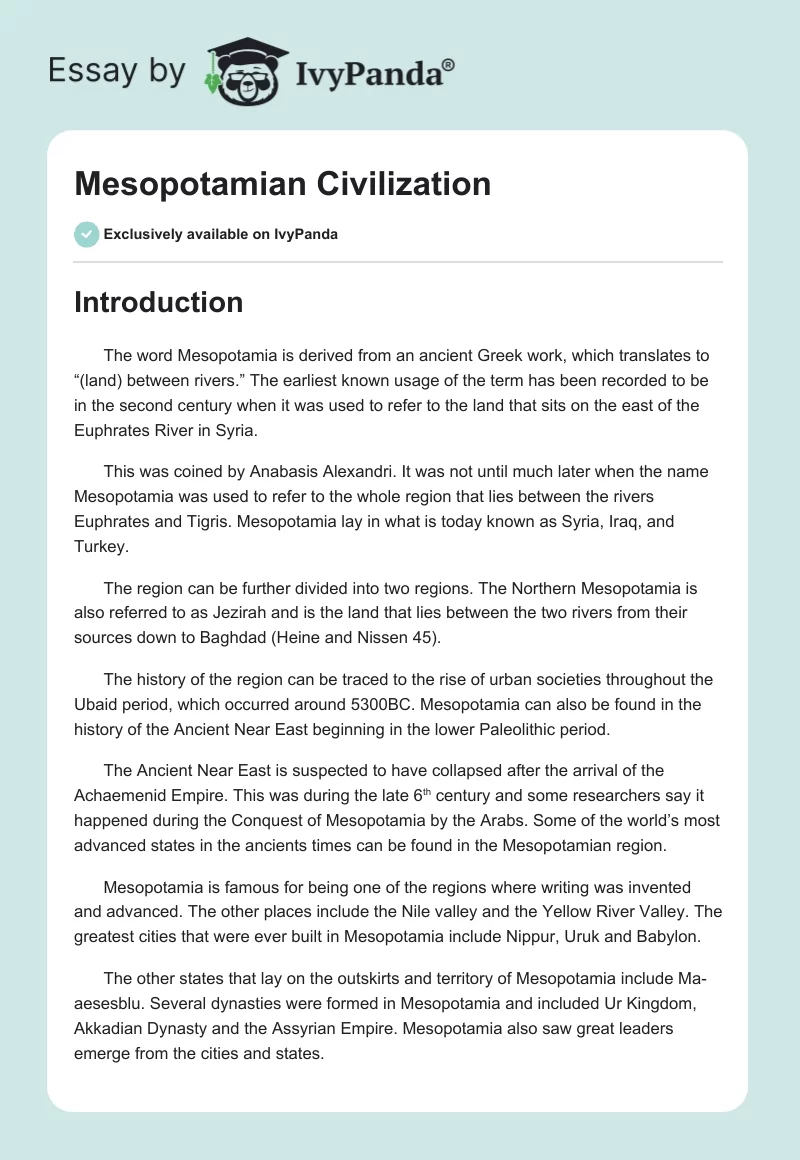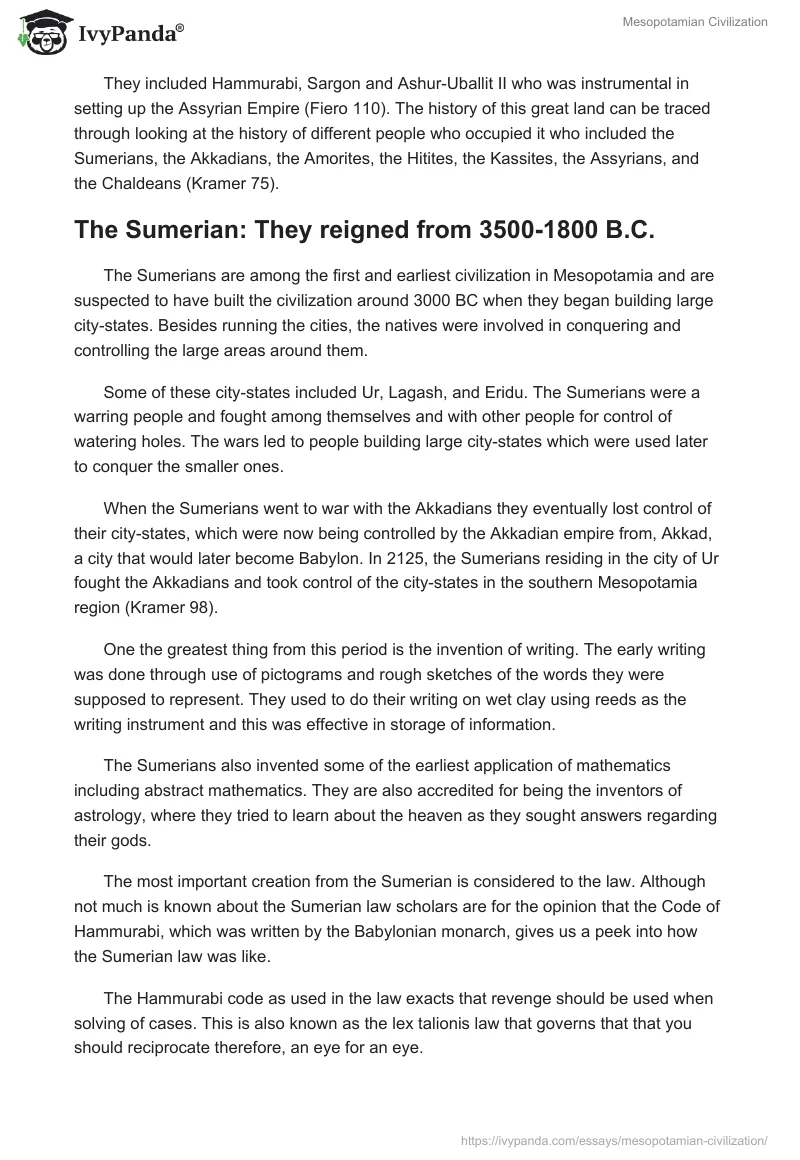Introduction
The word Mesopotamia is derived from an ancient Greek work, which translates to “(land) between rivers.” The earliest known usage of the term has been recorded to be in the second century when it was used to refer to the land that sits on the east of the Euphrates River in Syria.
This was coined by Anabasis Alexandri. It was not until much later when the name Mesopotamia was used to refer to the whole region that lies between the rivers Euphrates and Tigris. Mesopotamia lay in what is today known as Syria, Iraq, and Turkey.
The region can be further divided into two regions. The Northern Mesopotamia is also referred to as Jezirah and is the land that lies between the two rivers from their sources down to Baghdad (Heine and Nissen 45).
The history of the region can be traced to the rise of urban societies throughout the Ubaid period, which occurred around 5300BC. Mesopotamia can also be found in the history of the Ancient Near East beginning in the lower Paleolithic period.
The Ancient Near East is suspected to have collapsed after the arrival of the Achaemenid Empire. This was during the late 6th century and some researchers say it happened during the Conquest of Mesopotamia by the Arabs. Some of the world’s most advanced states in the ancients times can be found in the Mesopotamian region.
Mesopotamia is famous for being one of the regions where writing was invented and advanced. The other places include the Nile valley and the Yellow River Valley. The greatest cities that were ever built in Mesopotamia include Nippur, Uruk and Babylon.
The other states that lay on the outskirts and territory of Mesopotamia include Ma-aesesblu. Several dynasties were formed in Mesopotamia and included Ur Kingdom, Akkadian Dynasty and the Assyrian Empire. Mesopotamia also saw great leaders emerge from the cities and states.
They included Hammurabi, Sargon and Ashur-Uballit II who was instrumental in setting up the Assyrian Empire (Fiero 110). The history of this great land can be traced through looking at the history of different people who occupied it who included the Sumerians, the Akkadians, the Amorites, the Hitites, the Kassites, the Assyrians, and the Chaldeans (Kramer 75).
The Sumerian: They reigned from 3500-1800 B.C.
The Sumerians are among the first and earliest civilization in Mesopotamia and are suspected to have built the civilization around 3000 BC when they began building large city-states. Besides running the cities, the natives were involved in conquering and controlling the large areas around them.
Some of these city-states included Ur, Lagash, and Eridu. The Sumerians were a warring people and fought among themselves and with other people for control of watering holes. The wars led to people building large city-states which were used later to conquer the smaller ones.
When the Sumerians went to war with the Akkadians they eventually lost control of their city-states, which were now being controlled by the Akkadian empire from, Akkad, a city that would later become Babylon. In 2125, the Sumerians residing in the city of Ur fought the Akkadians and took control of the city-states in the southern Mesopotamia region (Kramer 98).
One the greatest thing from this period is the invention of writing. The early writing was done through use of pictograms and rough sketches of the words they were supposed to represent. They used to do their writing on wet clay using reeds as the writing instrument and this was effective in storage of information.
The Sumerians also invented some of the earliest application of mathematics including abstract mathematics. They are also accredited for being the inventors of astrology, where they tried to learn about the heaven as they sought answers regarding their gods.
The most important creation from the Sumerian is considered to the law. Although not much is known about the Sumerian law scholars are for the opinion that the Code of Hammurabi, which was written by the Babylonian monarch, gives us a peek into how the Sumerian law was like.
The Hammurabi code as used in the law exacts that revenge should be used when solving of cases. This is also known as the lex talionis law that governs that that you should reciprocate therefore, an eye for an eye.
The law also recognized class distinction and people were judged according to the class they came from. The laws set marked a basis for many of the following Semitic conquerors including the Babylonians and the Assyrians.
The Akkadians: they reigned from 2340-2125 B.C.
The history of the Akkadians before they conquered the Sumerians is not well known though they are known to have migrated to the North. In the year 2340, the Akkadian built their empire under the leadership of Sargon. The capital city they built, Akkad, was later renamed to Babylon by those who conquered it later.
The city was used as a commercial hub in the Mediterranean region and was used for close to 200 years for this purpose. The Akkadian empire under the leadership of Sargon was short lived because in 2125, the Sumerians in the city of Ur revolted against his rule and set pace for the renewal of other Sumerian cities (Heine and Nissen 89).
The Amorites reigned from 1800 to1530 B.C.
When the Sumeriam kingdom fell, Mesopotamia witnessed many battles that lasted for almost a century until the Amorites grouped and formed a Kingdom that had a centralized form of government. They based the capital of the government in the city of Babylon and this gives the Amorites the name Old Babylonians (Heine and Nissen 110).
The Amorite dynasty lasted from 1900 to 1600 BC and it is referred to as the Old Babylonian period. In this period, the Old Babylonians believed that the monarch was a god and his word was the law. The all-powerful monarch devised new ways of administering the states and the resources.
He introduced taxation and involuntary military service. The greatest achievement made by the Amorites was centralization, unlike the Sumerian empire that had many autonomous and independent city-states the Old Babylonian was ruled from Babylon and consisted of several cities.
To achieve control and dominance of these cities the monarch took away the power and autonomy of most of them. The Amorites also adopted the code of Hammurabi and most of the crimes in the empire were punishable by death. The Amorites believed in many gods and took Marduk as the most powerful of all the gods (Somervill 156).
The Hitites: they reigned from 1600 to 717 B.C.
The Hitites are not known from where they came from but their empire was spread out across Mesopotamia to Palestine and Syria. The invasion of the Hitites marked the end of the Amorite dynasty and like those before them; they adopted the ways and culture of the natives thus continuing the heritage and tradition of the Sumerians.
The empire is cited to have been greatest between 1600 and 1200 BC and even during the invasion of by the Assyrians in 1300 BC, most of the Hitites cities grew independently until 717 BC when they were finally occupied by the Assyrians and other enemies.
The Hitites were traders and are responsible for spreading Mesopotamian law thought, political structure etc to the rest of the Mediterranean (Somervill 162).
The Kassites: 1530-1170 B.C.
The Hitites were among the most successful Indo-European invaders to conquer Mesopotamia, but their rule did not last long. When the Kassites conquered and controlled Mesopotamia, they renamed the Babylon city to Karanduniash.
They set the capital city of their empire in a new city they built known as Dorkurigalzu. During the reign of the empire, the Mesopotamia region witnessed many wars and this attributed to the short life of the Kassites Empire. The Kassites are referred to as barbarians and savages by the Assyrians who would later conquer them (Somervill 82).
The Assyrians: Their Reign was from 1170 to 612 B.C.
The Assyrians are depicted in most of the history of Mesopotamia as being ruled rather than ruling. They tried to create their own empire under the rule of Shamshi-Adad though this was short lived after the dream was crashed by Hammurabi. Control of the Assyrian cities over the centuries changed hands from the Assyrians and the southern people.
The various times the region was under the rule of the Assyrians includes 1235-1198 BC under Tukulti-Ninurta, 116-1090 BC under Tiglat-Pileser, 883-824 under Ashurnarziparl II and Shalmeneser III who spread the reach of the kingdom to Syria and Babylon.
It is also during the reign of this dynasty that saw the Jewish diaspora when Sargon II (721-705 BC), deported the Jews after conquering Israel. The Assyrian empire was built through wars, invasions, and conquests. The empire is accredited with innovation in the mathematics field. They were also the first to apply longitudes and latitude in geographical maps (Somervill 62).
The Chaldeans: Also Known As Neo Babylon from reigned from 612 to 539 BC
They are the last people who are Semites to rule Mesopotamia after the Assyrian Kingdom fell. After much suffering in the hands of the Assyrians Babylon revolted against them and they burnt down the capital city of the Assyrian empire Nineveh.
The leader of the Babylonians was Nabopolassar and was succeeded by Nebuchadnezzar II (605-562 BC) who protected his empire from being conquered by the Egyptians and Syria. Under Nebuchadnezzar the capital city Babylon was rebuilt and upon its completion, it was the most splendid city in the Middle East.
The whole period the empire was under the Babylonian there were many wars and this resulted to the empire ending in 555 BC after the rule of the empire fell to a king who was loyal to the Assyrians.
He defiled Marduk the Babylonian god and this resulted to the priests welcoming the occupation of the region by Cyrus the Conqueror of Persia. This marked the end of the region dominance by the Semites (Heine and Nissen 120).
Works Cited
Fiero, Gloria. Landmarks in Humanities. Boston : McGraw-Hill Higher Education, 2009. Print.
Heine, Peter and Nissen, Hans. From Mesopotamia to Iraq: a concise history. The University of Chicago Press, 2009. Print.
Kramer, Samuel. The Sumerians: their history, culture, and character. Chicago: University of Chicago Press, 1963. Print.
Somervill, Barbara. Empires of Ancient Mesopotamia: Great Empires of the Past. New York: Chelsea House, 2010. Print.


